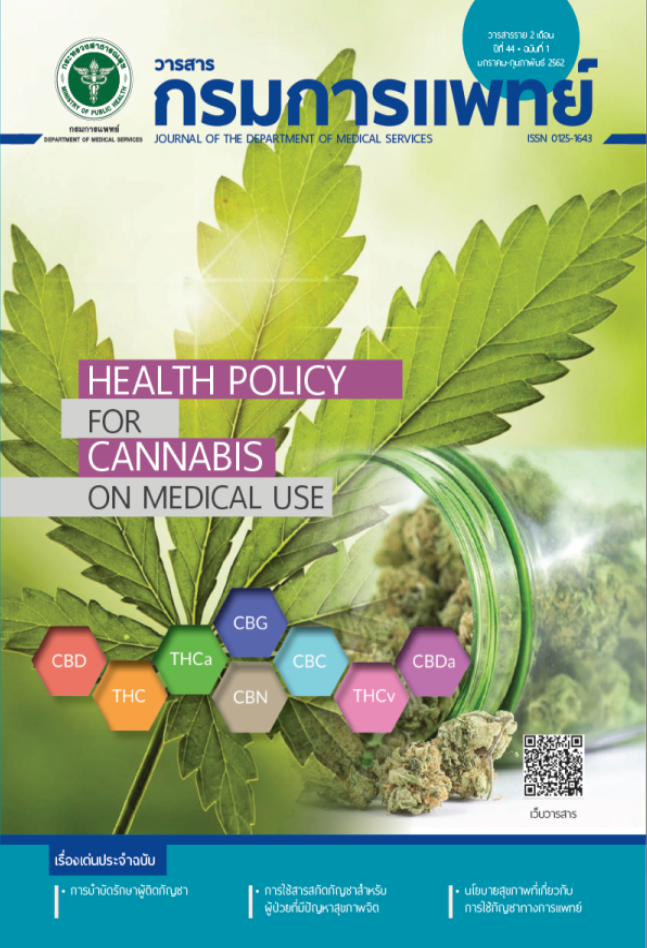Retention of Fissure Sealing using Ultraseal XT Hydro and Embrace on Occlusa l Surfaces o f Partially Erupted Permanen t Molars
Keywords:
Retention, Sealant, Partially erupted permanent molarsAbstract
This quasi-experimental research was conducted to evaluate and compare the retention of Ultraseal XT Hydro and Embrace sealant on occlusal surfaces of partially erupted permanent molars. 264 teeth of children aged 5-17 years were sealed with two sealants using matched pair design at Pakchongnana hospital. Total samples had stage of partially eruption that showed entire occlusal surface exposed without overlying tissue, but the distal gingival tissue was adjacent to and at the height of distal marginal ridge or tissue operculum extended over distal marginal ridge. The research instrument was record form verified content validity by experts. Data were collected for general data and retention at 6 months between 15 July 2015 and 14 February 2018. The descriptive statistics were frequency and percentage, and inferential statistic was Chi-square. The results were as follows; 77.3% of Ultraseal XT Hydro were completely retained while 73.5% were retained in Embrace group at 6 months. No statistically significant difference was noted between types of sealant and retention. Sealing with hydrophilic sealant may be the better choice when salivary contamination is expected. However further long-term studies are required to investigate this finding and compare with other sealing materials.
References
Brown LJ, Selwitz RH. The impact of recent changes in the epidemiology of dental caries on guidelines for the use of dental sealants. J Public Health Dent 1995; 55: 274-91.
Macek MD, Beltrán-Aguilar ED, Lockwood SA, Malvitz DM. Updated comparison of the caries susceptibility of various morphological types of permanent teeth. J Public Health Dent 2003; 63 : 174-82.
Helm S, Seidler B. Timing of permanent tooth emergence in Danish children. Community Dent Oral Epidemiol 1974; 2: 122-9.
Carvalho JC, Ekstrand KR, Thylstrup A. Results after 1 year of non-operative occlusal caries treatment of erupting permanent first molars. Community Dent Oral Epidemiol 1991; 19: 23-8.
Bureau of Dental Public Health, Department of Health, Ministry of Public Health Report of the 8th National Oral Health Survey, Thailand 2017. [Internet] 2561 [Travel on 15 September] 2561] From: http://dental2.anamai.moph. go.th/ewtadmin/ewt/dental/ewt_dl_link.php?nid=2422& filename = pd
Going RE, Haugh LD, Grainger DA, Conti AJ. Four-year clinical evaluation of a pit and fissure sealant. J Am Dent Assoc 1977; 95: 972-81.
Mertz-Fairhurst EJ, Fairhurst CW, Williams JE, Della-Giustina VE, Brooks JD. A comparative clinical study of two pit and fissure sealants: 7-year results in Augusta, GA. J Am Dent Assoc 1984; 109: 252-5.
Sterritt GR, Frew RA, Rozier RG, Brunelle JA. Evaluation of a school-based fluoride mouth rinsing and clinic-based sealant program on a non-fluoridated island. Community Dent Oral Epidemiol 1990; 18: 288-93.
Lussi A. Validity of diagnostic and treatment decisions of fissure caries. Caries Res 1991; 25: 296-303.
Feldens EG, Feldens CA, de Araujo FB, Souza MA. Invasive technique of pit and fissure sealants in primary molars: A SEM study. J Clin Pediatr Dent 1994; 18: 187-90.
Selwitz RH, Nowjack-Raymer R, Driscoll WS, Li SH. Evaluation after 4 years of the combined use of fluoride and dental sealants. Community Dent Oral Epidemiol 1995; 23: 30-5.
Aranda M, Garcia-Godoy F. Clinical evaluation of the retention and wear of a light-cured pit and fissure glass ionomer sealant. J Clin Pediatr Dent 1995; 19: 273-7.
Waggoner WF, Siegal M. Pit and fissure sealant application: updating the technique. J Am Dent Assoc 1996; 127: 351-61.
Songpaisan Y, Bratthall D, Phantumvanit P, Somridhivej Y. Effect of glass ionomer cement, resin-based pit and fissure sealant and HF application on occlusal caries in developing country field trial. Community Dent Oral Epidemiol 1995; 23: 25-9.
Hoffman I. A moisture tolerant resin based pit and fissures sealant application. Dental Tribune 2009; 17A-8A.
Dennison JB, Straffon LH, More FG. Evaluating tooth eruption on sealant efficacy. J Am Dent Assoc 1990; 121: 610-4.
Raadal M, Utkilen AB, Nilsen OL. Fissure sealing with a light-cured resin-reinforced glass-ionomer cement (Vitrebond) compared with a resin sealant. Int J Paediatr Dent 1996; 6: 235-9.
Boksman L, Gratton DR, McCutcheon E, Plotzka OB. Clinical evaluation of a glass ionomer cement as a fissure sealant. Quintessence Int 1987; 18: 707-9.
Mejare I, Mjor IA. Glass ionomer and resin-based fissure sealants: a clinical study. Scand J Dent Res 1990; 98: 345-50.
Simonsen RJ. Glass ionomer as fissure sealant - a critical review. J Public Health Dent 1996; 56: 146-9, 161-3 (discussion).
Poulsen S, Breiruti N, Sadat N. A comparison of retention and the effect on caries of fissure sealing with glass-ionomer and resin-based sealant. Community Dent Oral Epidemiol 2001; 2: 298-301.
Simonsen RJ. Pit and fissure sealant: review of the literature. Pediatr Dent 2002; 24: 393-414.
Pardi V, Pereira AC, Mialhe FL, Meneghim Mde C, Ambrosano GM. A 5-year evaluation of two glass-ionomer cements used as fissure sealants. Community Dent Oral Epidemiol 2003; 31: 386-91.
Chestnutt IG, Schäfer F, Jacobson AP, Stephen KW. The prevalence and effectiveness of fissure sealants in Scottish adolescents. Br Dent J 1994; 177: 125-9.
Suwansingha O, Rirattanapong P. Effect of fluoride varnish on caries prevention of partially erupted of permanent molar in high caries risk. Southeast Asian J Trop Med Public Health 2012; 43: 808-13.
Prabakar J, John J, Arumugham IM, Kumar RP, Srisakthi D. Comparative evaluation of retention, cariostatic effect and discoloration of conventional and hydrophilic sealants - A single blinded randomized split mouth clinical trial. Contemp Clin Dent 2018; 9 Suppl 2: S233-9.
Prabhakar AR, Murthy SA, Sugandhan S. Comparative evaluation of the length of resin tags, viscosity and microleakage of pit and fissure sealants - an in vitro scanning electron microscope study. Contemp Clin Dent 2011; 2: 324-30.
O’Donnell JP. A moisture-tolerant resin-based pit-andfissure sealant: Research results. Inside Dentistry 2008; 4: 50-2.
Antonson SA, Antonson DE, Brener S, Crutchfield J, Larumbe J, Michaud C, et al. Twenty-four month clinical evaluation of fissure sealants on partially erupted permanent first molars: glass ionomer versus resin-based sealant. J Am Dent Assoc 2012; 143: 115-22.
Downloads
Published
How to Cite
Issue
Section
License
บทความที่ได้รับการตีพิมพ์เป็นลิขสิทธิ์ของกรมการแพทย์ กระทรวงสาธารณสุข
ข้อความและข้อคิดเห็นต่างๆ เป็นของผู้เขียนบทความ ไม่ใช่ความเห็นของกองบรรณาธิการหรือของวารสารกรมการแพทย์



